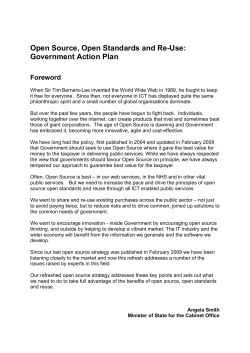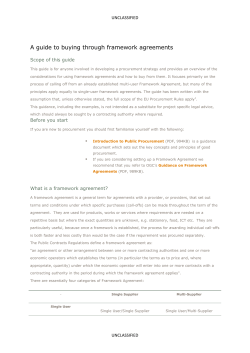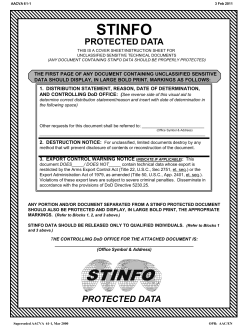
WIPE SAMPLE INTERPRETATION
UNCLASSIFIED US ARMY PUBLIC HEALTH COMMAND (Provisional) WIPE SAMPLE INTERPRETATION E2S2 Conference Denver, 14-17 June 2010 George Murnyak, CIH USAPHC Environmental Health Risk Assessment Program UNCLASSIFIED Purpose UNCLASSIFIED • Describe the rationale and logic used to assess health risks associated with chemical contamination on indoor surfaces • USAPHC developed TG 312 for office environments • Will not address issues related to collecting a “good” wipe sample UNCLASSIFIED Background and Scope UNCLASSIFIED • Few published health-based wipe sample standard/guidelines • The development of TG 312 was an evolutionary process over time • Guide is written in two parts; – First part basic concepts/explanation for general preventive medicine community – Second part detailed discussion of methodology for health risk assessors UNCLASSIFIED Evolution of Technical Guide 312 UNCLASSIFIED • Pesticide residues at military housing • Johnston Atoll Chemical Agent Disposal System (JACADS) • Developed screening levels for construction/demolition workers • Research laboratory converted to office • Explosive residues in storage buildings • Past herbicide research in laboratory UNCLASSIFIED Problem UNCLASSIFIED • Contrast the health risk interpretation: - Drinking water - Food consumption - Surface wipe samples • Basic EPA Risk Methodology equates health risk to magnitude of chemical intake. • How to estimate an Average Daily Intake (ADI) from available environmental data? UNCLASSIFIED UNCLASSIFIED EPA Health Risk Fundamentals Health Effects Human Health Formula Cancer risk ILCR (Incremental Lifetime Cancer Risk) ILCR = Chemical Intake X Cancer Slope Factor Noncancer HQ (Hazard Quotient) UNCLASSIFIED HQ = Chemical Intake Reference Dose Cancer Example UNCLASSIFIED ILCR = chemical intake X cancer slope factor example: A person incidentally ingesting sediment containing arsenic with a calculated intake of 7.23E-08 mg/kg-day 7.23E-08 mg/kg-d X 1.5 (mg/kg-d)¯¹ = 1.08E-07 UNCLASSIFIED Non Cancer Example- HQ UNCLASSIFIED example: A worker incidentally ingests surface water with a calculated intake of 3.66E-07 (mg/kg/day) of thallium 3.66E-07 (mg/kg/d) HQ = 7.00E-05 (mg/kg/d) HQ = 5.2 E-03 UNCLASSIFIED Drinking Water Example UNCLASSIFIED • Measure chemical concentration • Estimate daily water intake • Concentration x consumption = mg UNCLASSIFIED Food Consumption Example UNCLASSIFIED • Measure concentration in fish tissue • Estimate fish consumption • Concentration x consumption = mg UNCLASSIFIED UNCLASSIFIED Wipe Sample Example • Assume perfect sampling results of 50ug/100 cm2 • How do we use this surface sampling information to estimate intake? UNCLASSIFIED UNCLASSIFIED Sampling Scenario Child Day Care Center UNCLASSIFIED UNCLASSIFIED Sampling Scenario Locked Mechanical Room UNCLASSIFIED UNCLASSIFIED Potential Exposure Pathways Direct dermal contact Indirect ingestion from “mouthing behavior” Inhalation of settled particles resuspended from surface X Inhalation of semi-volatiles absorbed to surfaces (e.g., laminated, plastic) UNCLASSIFIED UNCLASSIFIED Wipe Sample Interpretation Exposure Assessment Exposure Route EPA Method Inhalation Surface Contamination Skin Total Intake Estimated Health Risk Level Ingestion -3 (SA r Fd r FTss r Cs r Ff r FTsm r EVing) EF r ED r 10 ADI ing = BWrAT _ UNCLASSIFIED UNCLASSIFIED Incidental Ingestion (fingers) PDingestion ( fingertips ) SA Fd FTSS CS Ff FTSM PDingest Potential ingestion dose (mg/event) SA Exposed skin surface area per event (cm2/event) Fd Fraction exposed skin surface area that actually contacts the surface (unitless) FTss Fraction transferred from surface to the skin (unitless) Cs Contaminant surface loading (mg/cm2) Ff Fraction exposed skin area that contacts the mouth (unitless) FTsm Fraction substance transferred from the skin to mouth (unitless) UNCLASSIFIED UNCLASSIFIED Wipe Sample Interpretation Exposure Assessment Exposure Route EPA Method Inhalation Surface Contamination Estimated Health Risk Level Skin Total Intake Ingestion ADI derm = (SAirFdi)rFTssrCsrABSrEVdermrEFrEDr10-3 BWrAT _ UNCLASSIFIED UNCLASSIFIED Wipe Sample Interpretation Exposure Assessment Exposure Route EPA Method Inhalation Skin Surface Contamination Estimated Health Risk Level Total Intake Ingestion ADI inh = fresprCsr104rAsrR V( depr a) ( ) UNCLASSIFIED r IRinhrETrEFrEDr10-3 BWrAT UNCLASSIFIED Wipe Sample Interpretation Safe Wipe Level Calculation Exposure Route EPA Method Ingestion Surface Contamination Skin Total Intake Estimated Health Risk Level Inhalation Safe Health Risk Level Exposure Calculations UNCLASSIFIED Safe Surface Wipe Level UNCLASSIFIED Wipe Sample Interpretation Example Comparisons Substance Beryllium PCB 2,3,7,8 TCDD Source Safe level (ug/100 cm2) DOE 3 and 0.2 TG 312 4.7 TSCA EPA 10 TG312 1.60 and 9.04 Michaud et al. 7.5 EPA WTC 0.00002 TG312 0.0000354 Michaud et al. 0.00125 UNCLASSIFIED UNCLASSIFIED Wipe Sample Interpretation References Michaud, et al (1994) “PCB and Dioxin Re-Entry Criteria for Building Surfaces and Air”, Journal of Exposure Analysis and Environmental Epidemiology, Vol 4, No. 2. Contaminants of Potential Concern Committee (2003) “World Trade Center Indoor Environment Assessment: Selecting Contaminants of Potential Concern and Setting Health-Based Benchmarks”. USACHPPM, (2009)Technical Guide 312 Health Risk Assessment Methods and Screening Levels for Evaluating Office Worker Exposures to Contaminants on Indoor Surfaces Using Surface Wipe Data. UNCLASSIFIED UNCLASSIFIED Wipe Sample Interpretation References (cont) Department of Energy, 10 CFR Part 850, Chronic Beryllium Disease Prevention Program; Final Rule Toxic Substance Control Act, PCB Regulations: 40 CFR Part 761.61, PCB remediation waste. Nicas, M Et al (2008) “A Study Quantifying the Hand-to-Face Contact Rate and Its Potential Application to Predicting Respiratory Tract Infection”, Journal of Occupational and Environmental Health. UNCLASSIFIED UNCLASSIFIED Acknowledgements • Ms. Hsieng-Ye Chang, MS, JD, PE DuPont de Nemours • Ms. Ronie Shackelford, BA, MA USAPHC (Provisional) UNCLASSIFIED UNCLASSIFIED Backup Slides UNCLASSIFIED UNCLASSIFIED Inhalation of Resuspended Surface Particles C air f resp C s 10 4 As R V dep V a Cair Resuspended air concentration (mg/m3) Cs Contaminant surface loading (mg/cm2) fresp Fraction respirable (unitless) 104 Units conversion, cm2 to m2 As Source area (m2) V Room volume (m3) R Resuspension rate (1/hr) λdep Deposition loss rate (1/hr) λa Air exchange rate (air changes per hour [ACH]) UNCLASSIFIED UNCLASSIFIED Direct Dermal Contact n PDdermal SAi Fd i FTSS C s i 1 PDdermal Potential dermal dose (mg/event) SAi Exposed skin surface area per event (cm2/event) Fdi Fraction exposed skin surface area that actually contacts the surface (unitless) i Body part in contact with the surface (e.g., hand, forearm) n Total number of body parts in contact with the surface FTss Fraction transferred from surface to the skin (unitless) Cs Contaminant surface loading (mg/cm2) UNCLASSIFIED
© Copyright 2025














